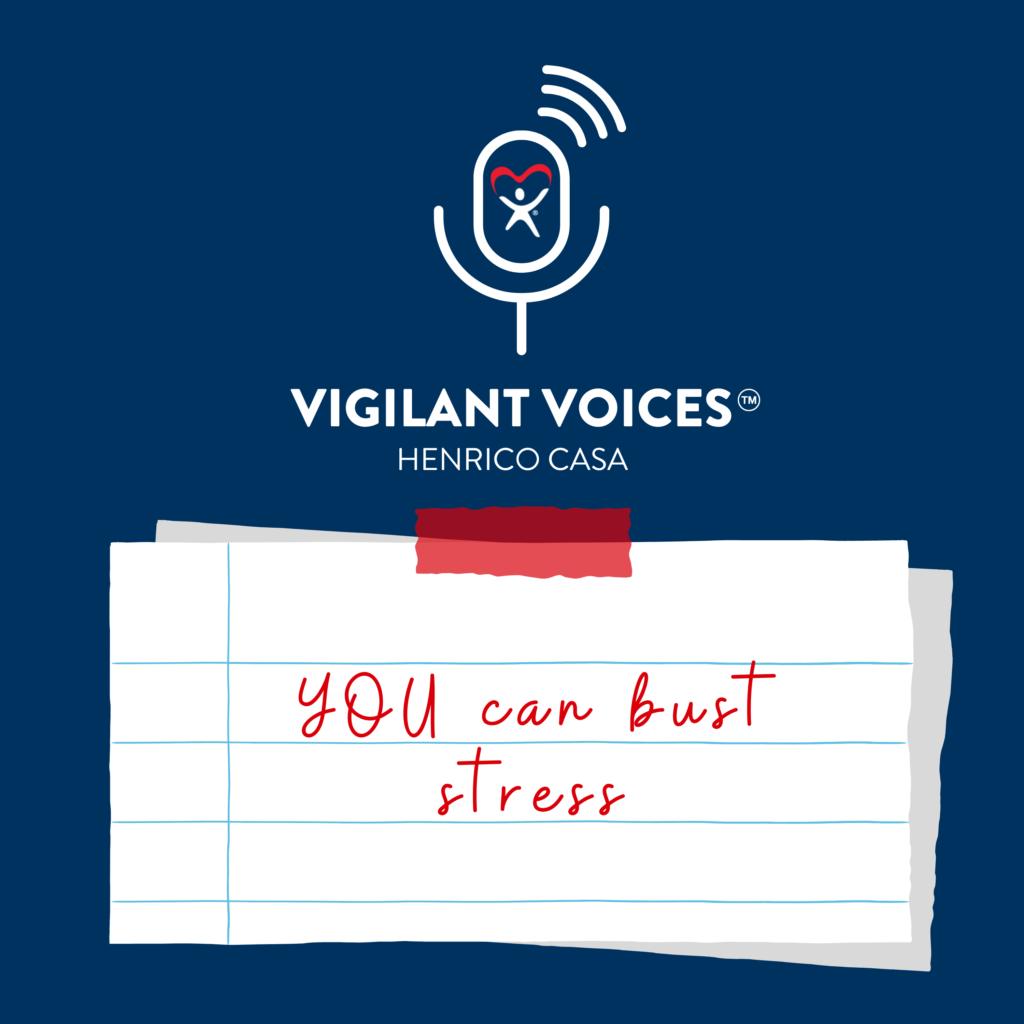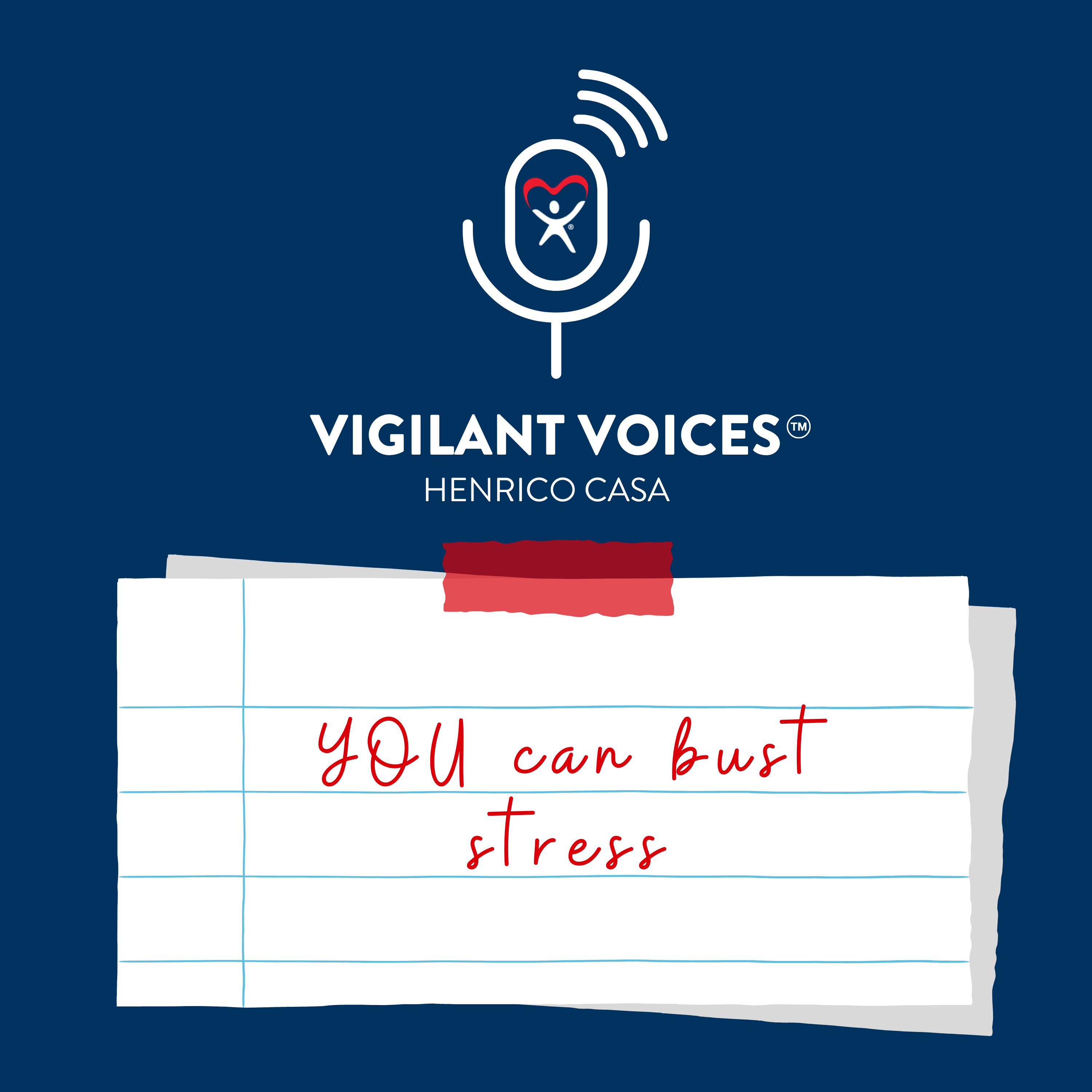
Listen to Episode 14 of the Vigilant Voices™ podcast, YOU Can Bust Stress.
Kristin Blalock: Hello, listeners! Thanks for joining us for the Vigilant Voices™ podcast.
Jeannine Panzera: This podcast is an extension of our work at Henrico CASA, which stands for Court Appointed Special Advocates. In our full time jobs at CASA, we serve children who have experienced abuse and neglect to make sure that they have a safe adult by their side as they navigate not only the court process but really the entirety of the child welfare system.
K: Sure, but we’d love to put ourselves out of work by preventing abuse and neglect for children like these. So this podcast is just one of many ways that we help our community know about the challenges facing children and families in order to ensure that one day, no child faces abuse, neglect, or trauma.
J: And, you know, Kristin, we’ve definitely noticed that many of the challenges facing children and families often times really boil down to a lack of resources or just a lack of support. And when I say lack of resources, there are many programs, services, organizations that these families can tap into for help. And we think of ourselves as connectors to these resources.
K: Definitely. We are connectors. And in terms of the lack of support, we’re hoping that this podcast gives you, listener, ideas every single episode on things you can do to be a support to children or families. Because often there is a stressor that’s the underlying cause of abuse or neglect. And if we can find ways to prevent that stressor and/or help someone cope with that stressor, we can in essence stop abuse or neglect before it even starts, right?
J: And let’s be real. Life is hard, okay? And we can’t live in a bubble safe from stress and some stress can be good, but we really need to learn how to manage the stress that is just inevitable in our lives.
K: Yeah, we need stress busters. So we wanted today to talk about what can help you, listener, what can help us, what can help all of us get through stressful times.
J: And I’m sure that you probably had quite a few CASA stories to share that tie into this theme because really every one of our case stories that we share involves stress of some type of level.
K: That’s true. So today I was going to tell you about Bobby and Charlie. They’re siblings who have been dealing with the typical teenage stressors that we’ve all experienced but they also had the added strain of their parents’ contentious custody case. And so when their CASA advocate met them, they were coping with their stress in really unsafe ways. And so while their parents dispute was working its way through the court system, the judge ordered these teenagers to attend school, to abide by a curfew, and other things that would hopefully give them the structure and support they needed to avoid these unhealthy stress relievers like drugs and risky relationships.
J: There are definitely healthy ways to deal with stress and then there are unhealthy ways to deal with stress. And I know that Bobby and Charlie’s advocate, and really all of our advocates for that matter, try to offer and model healthy coping skills while they’re working with these children and families.
K: Yeah. And that’s what we’re going to do today, is to offer all of us a slew of ideas on how to manage stress. Because if even one of these ideas is new to you or appeals to you in some way, it’s worth trying.
J: I have a feeling people are really listening. So the key here, obviously, is to find what works for you or for your child, if your child’s the one who is really experiencing stress. Everyone is different. And we all really do need to become experts on our own bodies and minds .So there’s never going to be one stress buster that fits all people and circumstances, but hopefully there’s one.
K: Yeah. And before we dive in and note that the stress busters that we’re offering up to you today come from the Paces Connection site.
J: Love that site. One of our favorites.
K: It is. And we’re specifically referencing items from a 2020 report by the California Surgeon General that was called The Roadmap for Resilience.
J: Oh, this is a good one.
K: Of course we’ll link to all of this in our show notes for you.
J: So in this there are seven categories of stress busters offered from these resources, and for each there are so many ideas. So let’s go ahead and start.
K: Yeah, think of this as like a menu of stress busters to choose from. So first up is sleep. Getting enough sleep is definitely a stress buster.
J: So I feel like we all hear this all the time about how important sleep is for so many things. Yeah, but how can we get more sleep?
K: Right? So some suggestions are to get on a consistent sleep schedule and maybe to do that you might need to have like a winding down routine that just signals your body that rest time is coming, right? And that could include maybe you avoid electronics before bed. Maybe you cut off caffeine at a specific time. Maybe you exercise earlier in the day, not close to bedtime. You really just want to create a calm, quiet, cool, like temperature wise, cool, distraction free place for sleep.
J: And sleep can also come in the form of shorter pauses and naps. Or one of my favorite terms is a horizontal life pause, which I think is great. We all need them from time to time.
K: I love a good nap. And we probably know all the things that we’ve listed here. It’s really more about actually doing them. We all know we need sleep. But something else to keep in mind, thinking of sleep is just to make sure you truly embrace that it’s okay to rest. It’s necessary to prioritize sleep. So be patient with yourself. If getting to sleep is difficult, it will come and it is worthwhile, right?
J: All right, so sleep number one, stressbuster number two, is to eat well. So that means eating regular meals, eating a variety of healthy foods. Try our best to minimize sugar, processed foods, alcohol. And similar to the sleep suggestions ,it’s about creating space for calm. So slow down, enjoy your food, eat at a more relaxed pace.
K: Yeah. Even just sitting down to eat versus standing up or on the go. Taking that time to sit down just kind of brings your body down a notch.
J: It’s not just stuffing food in your mouth. Let me take a moment. So that’s great. All right. And then on to stress buster number three, which is engaging in physical activity.
K: Okay, wait, these are so interrelated! I know that when I have more physical activity, it’s actually easier to eat better and I definitely sleep better.
J: Absolutely. There’s no doubt about it. So I think it’s if you can get in one good habit to reduce stress, then the others actually may start to naturally follow. For physical activity, I think the key, especially if we’re talking about children and teens and really wanting them to be active, is sometimes we have to be creative and think of fun ways to move, what feels good for you or for them or brings them joy. But it’s really important to take that time every day, whether it’s walking or stretching or having a little dance party… something to make you move.
K: Right, right. At our house, we hung a pull up bar. And it’s fantastic because the kids just kind of jump on that and knock out a few pullups here and there throughout the day. Actually during COVID, when we were doing school at home, they would need a break from class and they just pop out there, knock out some pull ups, and then go back to work.
J: There we go. I like that. And it’s always easier to then really jump into and get into physical activity if it is readily available. I mean, that is a reality. But I don’t think you have to overcomplicate things. So you don’t have to have a full gym in your house, a jump rope or a hula hoop or a basketball, soccer ball, frisbee… anything that’s accessible to your family just to make you get out there.
K: Yeah, I love all those ideas because they’re simple.
J: Okay, so that’s three. Looking forward to stress buster number four. That one is to practice mindfulness.
K: And I think sometimes we build this up to be something more than it is because mindfulness sounds so formal, like yoga and meditation and prayer,
J: the ‘practice’ of mindfulness.
K: Right. But it doesn’t have to be that intimidating. There are so many apps out there now with various practices, timers, techniques. But in its simplest form, mindfulness is pausing to pay attention to how you feel. It’s noticing how you’re breathing and then make making adjustments to calm yourself down. Breathe slower. Breathe deeper. Follow a pattern like the 4-7-8.
J: Tell me again what the 4-7-8 is?
K: It’s just a cadence of breathing that has been noted to reduce anxiety and help with sleeplessness. You breathe in for four seconds. Hold the breath for 8 seconds. Slowly exhale for 7 seconds.
J: So simple. A great tool to teach kids! We’re up to stress buster #5 now – and that’s experiencing nature.
K: Which we actually did a whole episode on. Listener, make sure go back and play episode 10 which we called “You Can Find Calm Outside.”
J: In terms of experiencing nature, it again doesn’t have to be a big production to really make a difference on your stress level. Some ideas I wanted to pass along are to go outside every day! Take deep breaths of fresh air. Look at the sky. Just pause to feel the sunshine on your face. Smell flowers. Walk barefoot on grass. Touch a tree. These sensory moments are grounding.
K: They are. OK. So then stress buster #6 is to prioritize mental health. There are definitely professional resources out there and we encourage you to use them! In addition, we encourage you to minimize inputs that may be upsetting or cause anxiety – like the news or other media.
J: And really, it helps to make a plan for what to do when you do feel overwhelmed. If you make a plan when you are in a good mental state, you can then use it when stress amps up.
K: And it would be great if part of that plan was to connect with friends, family, coworkers. That is stress buster #7. Supportive relationships. Call someone. Text them. Take a walk together. Join a community group. There is no replacement for human interaction and connection. It is so important.
J: Nothing good comes from isolation. That is for sure.
K: So true. And Bobbie and Charlie from our CASA story learned this. Their CASA advocate invested a lot of time in them, just slowly building a supportive relationship. He patiently created the safe space the teens needed, even though they didn’t know they needed it! The case has now closed, with Bobbie and Charlie in a consistent schedule for seeing each of their parents. They know what to expect of their parents, and in return what is expected of them. And they have both conveyed that having a dedicated CASA advocate gave them the opportunity to express their feelings. One of the siblings said that their CASA was one of the few people who actually listened to them and seemed to care about what they said.
J: And I remember the other sibling saying that talking to their CASA helped them deal with the stress of knowing their parents had a combative relationship.
K: A great example of how a supportive relationship can make stress more manageable.
J: Should that be our call to action for the week? Identify the supportive relationships in your life… because when you need them, if you have already identified them, you will be more likely to reach out to them!
K: And do the same for the children in your life… help them identify emotionally safe people – peers and adults – who they can go too when the going gets tough.
J: Because we all know the going will get tough… but how we manage the stress makes all the difference!








